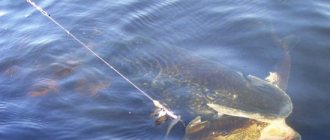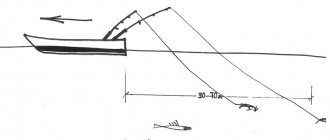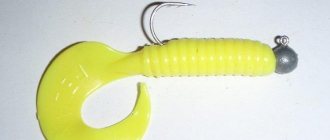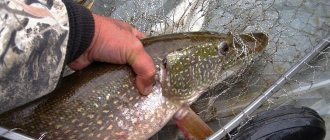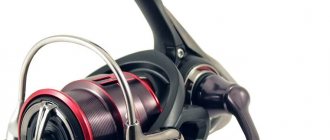Vibrating tails have long been very popular among spinning anglers, which is due both to their high efficiency and affordable cost. They imitate small fish that predators love to prey on.
The main design feature of these baits is the obligatory presence of a kind of tail, thanks to which they received not only their name, but also their expressive game.
The latter may differ in the amplitude and frequency of the generated oscillations, which depends, first of all, on the shape, size and angle of inclination of the tail.
Naturally, in order for a vibrating tail to attract the attention of a predator, it is necessary to take care of proper wiring.
Equipment for vibrating tails
Spinners who practice fishing with vibrotails use different methods of equipping these silicone baits.
Each method is good in its own way, and in different situations the same installation will be more or less preferable, which is due to the location of the hook relative to the vibrating tail.
There are the following options for vibrating tail equipment:
- On a jig head
- On offset hook via swivel joint
- On a double hook
- On the tee
Vibrating tail wiring
The technique of wiring vibrotails also involves variability. You can use the uniform wiring method, but it is not always effective. Pike perch are more often attracted by the effects of the jig head with bait hitting the bottom of the reservoir. In the case of a rocky bottom, a characteristic sound is produced, while when the tackle falls on a muddy bottom, a cloudy cloud is formed.
Important! On a rocky bottom, it is advisable to use tungsten weights; the thing is that tungsten rings loudly when it hits rocks, which very much attracts predatory fish due to the sound.
Many spinning athletes use baits on an offset hook with a swivel joint with tungsten Cheburashkas.
The jerking technique is good when fishing with vibrating tails. During a sharp jerk of the rod, the silicone bait quickly rises up, after which it smoothly falls again. To make it easier to record the moment the bait touches the bottom of the reservoir, it is recommended to use braided fishing line.
If you prefer a more relaxed fishing technique, you can, after casting the equipment, lift it by reeling in the fishing line. In this case, the bite is better recognized during the phase of lowering the bait to the bottom.
Another interesting method can be tested in practice when spinning fishing from a boat. Using a short spinning rod, the bait is lowered to the bottom, and then jerked with sharp movements of the hands. A pike perch can react to such a game of a vibrotail, loving to attack precisely when the bait falls to the bottom.
What is the difference between a vibrotail and a twister?
Today, fishermen have the opportunity to fish with twisters and vibrotails. What is the difference between these baits and which one should you prefer?
The main similarity between the two baits is the material used to make the products. The products are soft, plastic and have a peculiar tail. The twister resembles a caterpillar with a ring-shaped or ribbed body. During the movement, the tail of the device tries to straighten, which results in an interesting bending of the bait, as well as vibrations and oscillations. Thanks to such movements, it seems that a living organism is swimming, which undoubtedly attracts prey. The size of twisters is in the range of 3-20 cm. The largest products are used in the process of catching marine fish species. In stores you can buy products of various colors; the most popular are yellow, red, orange, white, silver and golden baits.
Read more
Cooking hominy for fishing
In the vibrotail, the motor element is the tail. As a result of the play of the product, vibrations are created, which are gradually transferred from the tail to the body. From the outside it seems that the bait moves naturally. The interesting color of the products adds even more naturalness. Even when fishing with vibrating tails in muddy water, an excellent effect is achieved.
This type of bait consists of a head, body, base of the tail and tail. A quality product should have a strong and dense head, an elastic and soft body, a movable base of the tail, and a flat tail. The most popular colors of the products are considered to be green, red, yellow and orange, but bluish-gray, white and transparent baits are also practiced.
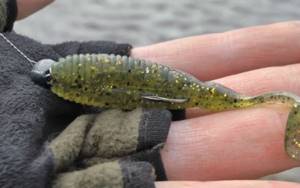
The material that is used to make the goods is the main similarity between the two baits
Vibrating tail installation
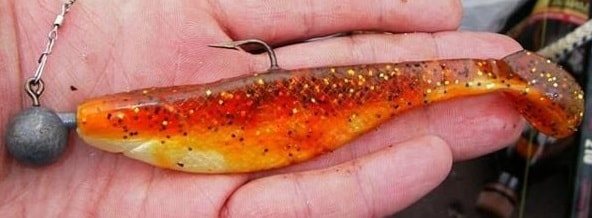
In order for the vibrotail not to fall off the hook and demonstrate a good game, it must be placed on the hook in the correct way. We advise you to prepare hooks and jig heads with bait in advance, and, of course, you will have a better chance of a good catch if you have several rigs with vibrating tails of different sizes and colors in your arsenal.
When using a jig head, the silicone vibrotail takes a position with its back up during the retrieve, and when using a hinged mount, the bait falls on its side.
Both positions are correct in their own way, since in the first case the bait looks more natural, and in the second it imitates a helpless, weak fish, which can also attract a hungry predator.
The hinged connection allows you to use both single hooks and doubles with tees without negative consequences for the action of the bait. Also, with an articulated joint, casting over long distances is better.
Related article: fishing with poppers
Rating of silicone vibrating tails for pike
There is a rich assortment of this type of bait on the Russian and foreign markets. Below is a rating of the best vibrating tails for pike, which can be purchased in Russian stores.
Vibro fat from the domestic company TM Crazy Fish. The shape and color of these vibrotails are developed taking into account the authoritative opinions of Russian and Ukrainian fishermen in order to adapt the baits to the conditions of our reservoirs. Vibro fat is aimed at the most common predators - pike, pike perch, perch or catfish. To allow rigging using an offset hook, there are special cutouts on the body, which makes this ripper ideal for use in hard-to-reach places. There are also holes for weights of various weights, which expands the possibilities of using the bait. The large area of the tail ensures stable play with any type of fishing, and a wide range of colors will allow you to adapt to any body of water. With a length of 7.1 cm, the ripper weighs 3 grams. One package comes with five baits, the price for it varies within 215 rubles.

Vibro worm 3.4 inches is also a representative of domestic rippers from Crazy Fish; the largest bait in the series, it weighs 4 grams and is 8.5 cm long. Thanks to the softness of the material from which the bait is made, it begins to play immediately. Moreover, this silicone is edible and additionally contains squid and garlic flavors. The package contains five pieces of rippers and has a price of around 200 rubles.
Fox Rage Fork Tail is a foreign vibrotail with V-shaped tail. Made of hard silicone with the addition of natural fish oil, this ripper easily misleads predators, dispelling their doubts that this is an artificial bait. The cut of the tail is made in such a way that at the slightest change in position in the water it begins to vibrate within a few seconds, which makes it extremely catchy when fishing vertically and when using a drop-shot rig. Of course, it is also suitable for mounting on a jig head or offset tackle, since the notch on the body of the bait ensures stable play during any retrieve on reservoirs with or without current. The line includes three universal lure lengths designed specifically for pike: 100 mm, 135 mm and 180 mm. A pack of 5 rippers will cost about 250 rubles.
Recommended reading: The most common knots for fluorocarbon fishing line
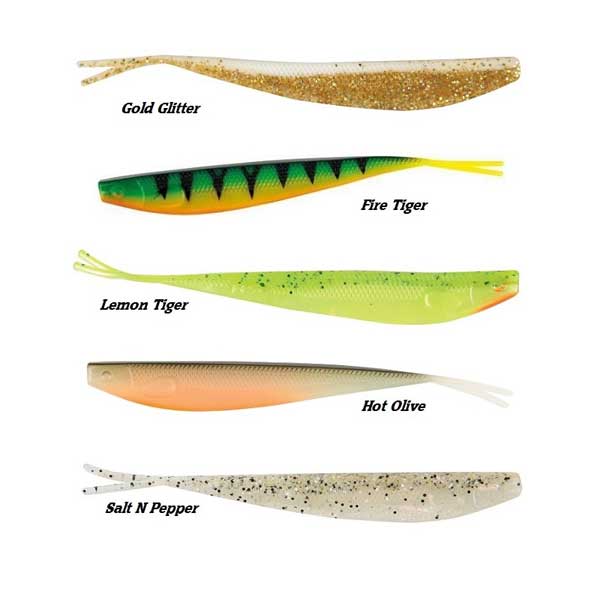
Lucky John Pro Series Mr Greedy is a high-quality foreign pike vibrating tail. Also made of edible rubber, it has many color options, as well as two large sizes of 7.6 cm and 9.9 cm. It has a flattened body with a wide tail that provides a powerful amplitude of play, as well as a special cutout for an offset hook. Any equipment can be used, Texas, Carolina, offset with a “Cheburashka” and even without a sinker at all. With all this, the ripper has excellent performance in its ability to bypass underwater obstacles without getting caught in them. However, when equipped with a classic jig head, this quality is lost. Accordingly, the number of baits in the package differs depending on the size and is 7 pieces for 7.6 cm and 5 pieces for 9.9 cm, and the price varies between 300 rubles and 400 rubles, respectively.
Spirit Manns is a budget vibrating tail that belongs to the classic shad and is made in the shape of a fish, which is made of soft silicone, which makes it very mobile and does not interfere with the bites of a predator. Moreover, due to its design, the bait plays with its entire body, and not just the tail fin, which allows the pike to notice it from a long distance. The equipment is made both for a traditional jig head and for a movable connection with a “Cheburashka”. There are rippers on the market with a wide range of colors offered and pike sizes of 9cm and 12cm, and come in packs of 3, 6, 10 and 20 pieces. The price, accordingly, varies from 50 rubles to 400 rubles.
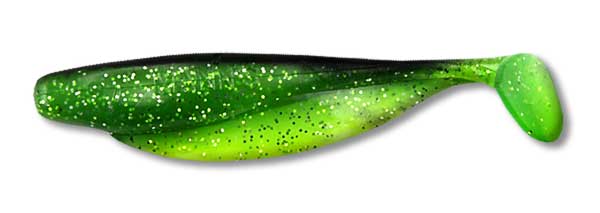
Tips for fishing with vibrotail
The catchability of baits depends on their visual similarity to the usual food of predators. For example, for fishing in still water, try using wide silicones that resemble the appearance of a roach or small crucian carp. In flowing water bodies, it is first of all recommended to try elongated vibrotails, similar to minnows or bleaks, which pike often feed on.
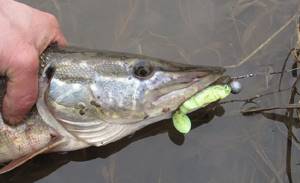
Most bites, as a rule, occur during the pause phase, which makes the action of the bait even more significant during the fall. If the mounted vibrotail has insufficient mobility, you can additionally make a couple of light cuts on the tail or increase the plasticity of the silicone by lowering it into hot water.
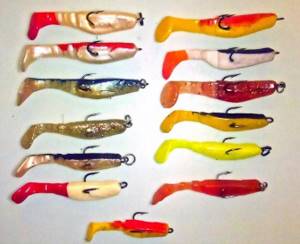
It cannot be said that the color of vibrotails plays the most important role, but this characteristic is also worth taking care of. More often, predators attack baits that resemble the color of small fish hanging around in a pond. In cloudy weather with light rain, preference should be given to silicones with a predominance of yellow and red colors in color, and on sunny days, silver vibrotails are primarily suitable.
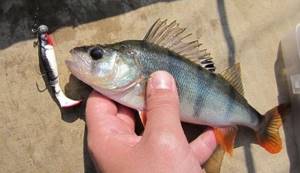
You should not follow the lead of marketers who promote a variety of vibrating tails with vibrating fins and other additional effects. Baits should be as similar as possible to the usual victims of predators, both in appearance and behavior.
It is worth noting that silicone baits can be upgraded by making slits on the belly with scissors. In this case, the tail becomes softer, which changes the frequency of movement of the vibrating tail. The number and width of cuts is determined experimentally. Example in the photo.
How to choose bait for pike
Silicone bait sharpened for pike fishing is selected according to the criteria of its size and hardness of the material. Since the pike has a fairly massive mouth with hundreds of sharp teeth, the bait should be quite hard and maximum dense. Frequent touching, and even more so the gripping of silicone by a fish, quickly renders it unusable, or even immediately puts it out of action, breaking off the tail. In addition, strong sharp blows to the bait during an attack allow the harder silicone to stay on the hook more firmly.

A vibrotail for pike is purchased at least five centimeters long. Smaller fish sizes will provoke smaller specimens of pike to come out, and the perch will not mind swallowing the bait, interfering with the pike fishing strategy.
Important! In appearance, pike vibrating tails are less elegant than baits for pike perch and pike perch; they look more massive and voluminous in shape.
It is worth paying attention to the presence of an active attractant in the bait.
Important! On sale, rubber of this type, impregnated with an attractant, is called edible.
Pike has a fairly well-developed sense of smell and the additional factor of smell will not be superfluous. Smells based on fishy tones are preferable, sharp and initially unpleasant for human perception. The presence of notches and ribs on the tail also has a positive effect on the performance characteristics of the bait. By creating additional vibrations and sounds, they perfectly lure passive fish out of their parking areas.
Lure color
Fishermen have different opinions about the color of the rubber. In my opinion, this is a significant factor in fishing success. Color affects the bite, depending on the depth of the reservoir. It has been proven that at depths, with decreasing illumination, colors change radically, and colors that seem attractive and noticeable in daylight at a depth of over four meters become practically indistinguishable. This refers to the faded clarity in the depths of white and yellow colors. But bright green, acidic and a combination of red and white are noticeable at depths much more intensely.

In shallow waters, baits interspersed with silicone additives with a reflective effect and glitter have proven themselves well. Especially in bright and sunny weather, baits of dark shades with such inclusions work with a bang. In shallow water, the color of the so-called machine oil, a shade of brown, is successful, and black can also activate the pike.
At depths of 2-3 meters, the red color and its shades have practically no equal in bite rates. Depending on the time of year, and therefore the water temperature, you can trace the following color pattern: blue color, with its shades, white, silver - activate fish in cold water, but exotic colors, such as acidic, carrot and combinations of various colors work in the warm season. Therefore, pike should be caught in the fall using blue and blue vibrotails, and in the summer, acidic and red-white combinations are preferable.
Shape and size
The vibrotail, according to its shape, is divided into two types.
Important! The first type: shad or fatty, this is a rubber with a rounded belly and a short tail. Used for catching pike in still water.
The massiveness and at the same time light heaviness and clumsiness in the movements of such a bait matches the behavior of live fish in stagnant bodies of water, which is typical for pike prey in such conditions.
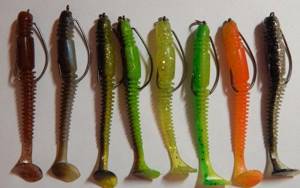
Important! The second type is longs or long elongated baits with thin tails in their central part. This type is designed for fishing in currents, where the deployment of a vibrating tail is associated with increased water resistance.
Here the silicone, like a living fish in natural conditions, gracefully resists the current, wriggling its entire body sharply.
Lure sizes, as mentioned above, range from five centimeters to twenty. The most popular sizes are eight and thirteen centimeters.
Important! The longer the silicone fish, the less intense its play when retrieved.
The size of the artificial fry does not always affect the size of the fish caught. A pike is capable of attacking a prey two-thirds its size, and it is possible to catch a trophy of ten kilograms for a five-centimeter high-spirited player. It all depends on the activity of the fish. In spring and autumn, when hungry, pike grab any moving object, regardless of its size. In the summer, a full-fed predator will only react to the provoking play of a small bait.
Caudal fin performance
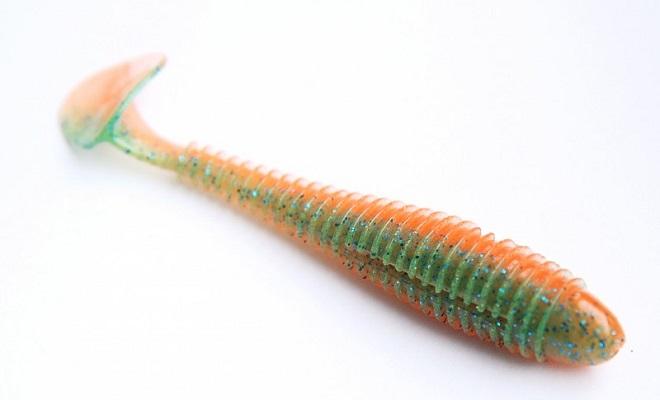
The performance of the bait's tail fin directly affects its activity during retrieve. When buying a vibrating tail, it makes sense to check whether it plays correctly. You can do this without leaving the store.
Important! Taking the vibrating tail from the side of the head in your hands, place it with the tail up and begin to swing it. The amplitude of tail swings should be frequent, mincing and absolutely symmetrical.
Thus, a proven vibrating tail will show even, energetic play on the water, without failures and uncontrolled diving and yawing around.
Catching pike with a vibrotail
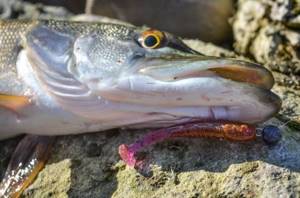
Lure size
Pike often attacks relatively large fish, which is why large-sized baits are used to catch them. Let us immediately note that this statement is not a rule at all; pike can bite on small silicone baits, but more often they still prefer “well-fed” vibrotails. The optimal length of lures for pike is from 8 to 15 cm, the most universal is 10-12 cm.
Also regarding the size of baits, it is worth saying that pike willingly take small vibrating tails in small reservoirs, while in large rivers and lakes they often attack larger baits. This fishing phenomenon is most likely associated with the usual food supply of this predator.
When purposefully fishing for pike, do not forget to use leashes on the equipment, which can be either metal or fluorocarbon with a thickness of 0.4 to 0.6 mm. The leash will protect your tackle from the sharp teeth of the pike!!!
Bait game
Sometimes the pike is wary, and therefore more often attacks the bait with a smooth, slow, natural game.
To ensure the latter, it is necessary not only to carry out the correct wiring, but also to select a bait with a sufficiently large, wide tail and heel. The vibrating tail must be of high quality, mobile, and not “wooden”.
Wiring
In order for the vibrotail to move slowly, weights with less weight are used than in the case of a standard jig “step”. A large load will turn the desired smooth retrieve into a regular dragging of the vibrotail along the bottom of the reservoir. If the pike perch reacts better and attacks the bait as it falls after a jerk, then the pike more often bites during a uniform horizontal sweep.
Shape of pike vibrotail
The pike vibrator looks like a fry with a short hoof-shaped tail. Vibrotails are distinguished by the shape of their body and tail.
Based on body shape, vibrotails are classified into:
- shads . This is a bait with a thickening in the middle part and a compact tail, reminiscent of a herring. The slight heaviness and clumsiness of such a “fat man” are characteristic of fish that live in reservoirs with stagnant water. They are the main food for catfish. Therefore, it is shad that will be effective when hunting for pike in holes and in water areas without a current. It is believed that shad are indispensable for catching trophy pike;
- longs (“long”). Elongated, oblong lures with a thin tail are designed for fishing in currents. Externally they look like bleak. Posting a ripper in such conditions is accompanied by resistance to the current, while it, like a living fish, sharply wags its body. This behavior is typical of a fry that has lagged behind the flock, which will certainly provoke the predator to attack. Narrow baits have better aerodynamic properties: they fly further and more accurately.
If there is an urgent need, a wide vibrating tail can always be turned into a narrow one by trimming the belly.
The appearance of pike vibrotails is less elegant compared to pike perch and perch rubber. They are more massive and voluminous.
The nature of the vibrating tail's play directly depends on the design features of the tail blade. According to this parameter, rippers are divided into:
- narrow-tailed rippers . Due to the low resistance to the oncoming flow of water, the tail section vibrates with high intensity. Such a ripper in motion imitates the behavior of a fussy fry;
- broad-tailed rippers . The large surface of the tail provides significant resistance to water flows, as a result of which the vibrotail plays leisurely, reminiscent of a clumsy toothed fish.
All kinds of improvements to the tail, such as notches and slits, significantly improve the dynamics of the game of the vibrotail, luring the passive predator out of its parking areas.
In addition, the success of fishing depends on the quality of the bait. You can evaluate the quality by holding it by the head, lifting it up with its tail and shaking it a little. A high-quality vibrating tail will oscillate in different directions with the same amplitude. The game of such a ripper will be stable even at low wiring speeds. The softness level of the bait is checked by swinging it by the tail.
Stepped wiring
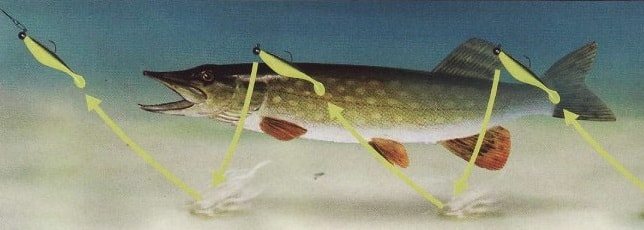
High-speed fishing is also used when fishing for pike, but more often only to search for a predator. When a pike is detected, the speed of the vibrotail is gradually reduced. Also, the bait is not initially cast too quickly in the case when the fisherman is confident in the presence of pike in the selected area of the reservoir. In addition, they experiment with the speed of the retrieve and when fishing conditions change, when the number of snags and other obstacles on the bottom increases or, for example, the weather changes.
